Destination: Lake Champlain
Historic waterway marks 400th anniversary, still boasts one of the best largemouth and smallmouth fisheries in the nation
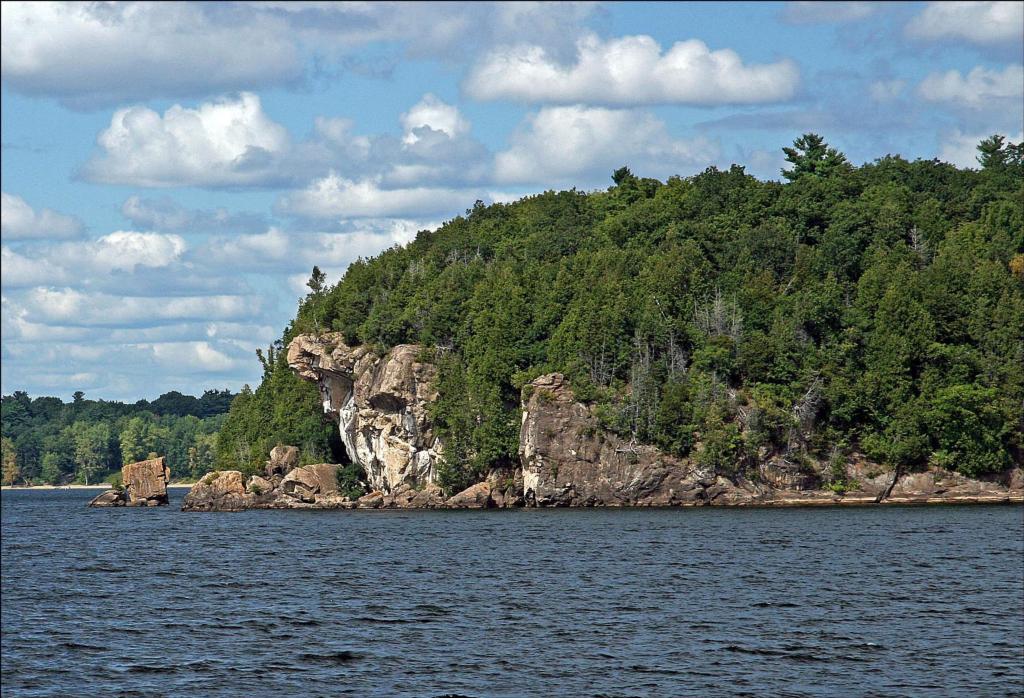
Four centuries ago, a French explorer surveyed a long, narrow lake tucked between the Adirondack and Green mountains and said, “Wow!” – or at least the 17th century equivalent expression. Today, not much has changed as Lake Champlain still conveys a sense of wonderment and breathtaking beauty for both newcomers and veteran anglers alike.
Straddling the borders of New York and Vermont, and reaching its northern tip into Canada, this fertile lake takes its name from Samuel de Champlain who officially discovered the sparkling waters in 1609 – a year after founding Quebec. Since that time, millions of anglers, history buffs and adventure seekers have continued to enjoy the pristine waters of Lake Champlain – arguably one of the most impressive and unique lakes in the entire nation.
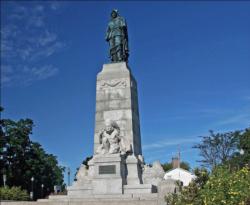 To commemorate the lake’s 400-year anniversary in 2009, communities all around the lake celebrated their landmark fourth centennial with host of festivals, parades and municipal ornamentation. And not surprisingly, Lake Champlain responded to the occasion by producing yet another year of tremendous fishing.
To commemorate the lake’s 400-year anniversary in 2009, communities all around the lake celebrated their landmark fourth centennial with host of festivals, parades and municipal ornamentation. And not surprisingly, Lake Champlain responded to the occasion by producing yet another year of tremendous fishing.
To underscore just how fantastic the fishing can be on Lake Champlain, Florida pro Scott Martin won the Walmart FLW Tour event last July with a final round weight of 36 pounds, 4 ounces. In August of 2009, New Hampshire pro Steve Lucarelli topped the Stren Northern Division tournament with a 3-day total of 57 pounds, which included a 20-pound, 6-ounce bag caught during the final day of ran-drenched competition.
Lucarelli, who guides on his home waters of Lake Winnipesaukee, gives props to Champlain for its unspoiled beauty. “Lake Champlain is not overdeveloped with million-dollar homes crammed onto every inch of shoreline. Farmland with rows of corn, silos, and cattle are still visible.”
Indeed, Champlain’s 121 miles of multi-featured coastline sport an eye-pleasing blend of rocky bluffs and rolling hills dressed with pines and maples, protected bays and quiet coves. The lake’s top half, from about Essex, N.Y., northward, spreads the widest, with Champlain’s Islands and a smattering of lesser islets dominating the upper limits. On the New York side, the lake’s major towns are Plattsburgh, located in the northwest end, and historic Ticonderoga at the south end. On the eastern shore, about mid-lake, resides Burlington – Vermont’s largest city.
Champlain links to the St. Lawrence River via the Richelieu River at its northwest end, thereby providing a navigable course to the Great Lakes and the Atlantic Ocean. At the south end, the Champlain Canal connects the lake with the Hudson River for another Atlantic route.
Even before the manmade linkage, Lake Champlain’s northern connection to the St. Lawrence made this an important body of water for early traders and, of course, the military efforts of France, Great Britain and the American Colonies. Among the notable engagements, the Battle of Valcour Island (Oct. 11-13, 1776) gave the British control of Lake Champlain during the Revolutionary War. Later, the Battle of Plattsburgh (Sept. 11, 1814) ended the final invasion of the northern states during the War of 1812.
Today, Lake Champlain sees a steady stream of cargo vessels, pleasure crafts and fishing boats. Salmon, lake trout and panfish swim these heralded waters, but bass remain the top draw.
Champlain offers great largemouth, smallmouth action
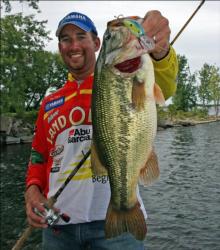 The coexistence of largemouth and smallmouth bass is not unique to Champlain, but the lake’s ability to produce competitive stringers of either species certainly commands the attention of anglers. Although certain times of the year may favor browns or greens, when both species are biting, this diversity provides anglers with myriad options. As such, tournament anglers often have the luxury of being able to switch gears to focus on one species when the other is playing hard to get.
The coexistence of largemouth and smallmouth bass is not unique to Champlain, but the lake’s ability to produce competitive stringers of either species certainly commands the attention of anglers. Although certain times of the year may favor browns or greens, when both species are biting, this diversity provides anglers with myriad options. As such, tournament anglers often have the luxury of being able to switch gears to focus on one species when the other is playing hard to get.
“Lake Champlain is arguably one of the best two-tier bass fisheries in the country,” Lucarelli said. “Spawning smallmouth can win any tournament during the spring. Then again, when the weeds get up in the summer, targeting largemouth can be more convenient and profitable. For the angler that can catch a mixed bag of both largemouth and smallmouth the result can be very rewarding.”
New Jersey pro Pete Gluszek said that Champlain owes its bounty to plentiful habitat and food. From yellow perch, to gobies, to crawfish, both bass find meals in no short supply. And with a collection of docks, fallen trees, rip-rap, offshore humps and rocky bottom with scattered weeds, Champlain keeps the action red hot from spring ice-out until winter freezes the lake.
Gluszek also points out the benefits of the lake’s trim figure. “Champlain is unique in that the largemouth and smallmouth haunts are located very close to one another. Often times, you can find both species within a couple miles of each other and sometimes they actively feed together.”
Given its inter-mountain location and elongated north-south orientation, Lake Champlain’s weather can change rapidly. Flexibility and backup plans are a must, as too much wind means treacherous main-lake conditions, while too little wind makes it tough to get bites in the clear water. Fortunately, Champlain presents plenty of leeward holes where you can usually find a decent bite.
“If you’re just visiting Champlain for a casual fishing trip, the wind isn’t much of a factor,” Gluszek said. “There are free launch ramps in every cove and creek on the lake. It’s very easy to drive around and find a protected place with (good) fishing. Rocky shoals throughout the lake make for good fishing, but they also present a navigation challenge. Good maps and a GPS unit are recommended.”
Angling overview
Summarizing Champlain’s general regions, Gluszek said the Vermont side of the north end – known as the Inland Sea – holds some of the nation’s best smallie action, along with largemouth in bays like Missiquoi, Albans and Mallets. On the New York side, Gluszek recommends hunting for largemouth in Kings Bay, Trumble Bay and The Gut. Conversely, smallmouth have predictable haunts from Plattsburgh all the way up to Canada.
“The central part of the lake is predominately smallmouth,” Gluszek said. “The water is clearer in this section and offers world-class smallie fishing from Burlington Bay in the east to the New York shoreline. Large flats and offshore humps are the predominate cover in this area.”
In the south end, experienced anglers typically run straight to the Ticonderoga area for stellar largemouth potential. Acres of milfoil grass provide prime cover for big fish and big numbers.
During the rough, wet conditions he faced on the final day of his Stren victory, Lucarelli relied on a drop-shot and Carolina-rigged lizard. Generally on Lake Champlain, he favors a black jig for largemouth and a jerkbait for smallies. “Smallmouth will always eat a jerkbait. Once you find the retrieve they want just hold on, the smallmouth will do the rest. The jerkbait covers a tremendous amount of water and the key to finding smallmouth is to keep moving. They’re here today and gone tomorrow.”
Champlain bass also seem to favor wacky-rigged Senkos, spinnerbaits, crankbaits, swimbaits and Texas-rigged plastics. Additionally, you’ll find some of the most exciting frog bites imaginable. And when calm conditions allow smallies to corral yellow perch near the surface, it’s topwater time.
Pennsylvania pro Jason Ober who won the 2008 Stren event on Champlain loves throwing a Zara Spook. “When those smallmouth come up and smack a topwater plug, it’s the most incredible thing you’ve ever seen. That’s why I come to Lake Champlain.”
Taking in the sites
 When it’s time to finally put down the fishing pole, there are plenty of rewarding day trips awaiting Lake Champlain visitors throughout the lake’s surrounding communities. For starters, downtown Plattsburgh is home to a host of historic churches, a self-guided Heritage Trail, a scenic riverwalk and several monuments, including a statue of Samuel de Champlain at the mouth of the Saranac River.
When it’s time to finally put down the fishing pole, there are plenty of rewarding day trips awaiting Lake Champlain visitors throughout the lake’s surrounding communities. For starters, downtown Plattsburgh is home to a host of historic churches, a self-guided Heritage Trail, a scenic riverwalk and several monuments, including a statue of Samuel de Champlain at the mouth of the Saranac River.
Burlington’s charming waterfront is a great place for weekend strolls. Specialty shops, local fare eateries and a tidy waterfront park with a dedicated bike trail make this a family-friendly center of activity. East of the waterfront, the University of Vermont’s stunning architecture, fountains and monuments are worth a visit. South of the waterfront district, the famous Lake Champlain Chocolate factory beckons those with a sweet tooth, while the Ben & Jerry’s Ice Cream factory sits about an hour to the east.
Lake Champlain’s other must-see destinations
If you are able to make a trip to Lake Champlain, make sure to hit these popular sites as well:
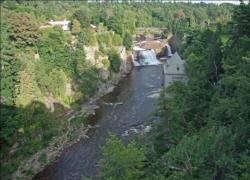 Ausable Chasm – Known as “The Grand Canyon of the East,” it’s the oldest natural wonder theme park in the U.S. Located about 30 minutes south of Plattsburgh, this ancient canyon plunges hundreds of feet to the Ausable River. A pedestrian lane on the Interstate 87 Bridge offers stunning views of the chasm and the beautiful Rainbow Falls, but you can also enjoy a closer look while tubing, rafting or wandering the self-guided trails.
Ausable Chasm – Known as “The Grand Canyon of the East,” it’s the oldest natural wonder theme park in the U.S. Located about 30 minutes south of Plattsburgh, this ancient canyon plunges hundreds of feet to the Ausable River. A pedestrian lane on the Interstate 87 Bridge offers stunning views of the chasm and the beautiful Rainbow Falls, but you can also enjoy a closer look while tubing, rafting or wandering the self-guided trails.
Ticonderoga – Historic sites are many throughout the town, but the namesake fort – often called the “Gibraltar of the North” – is the main attraction. Built by the French in 1775, this National Historic Landmark was also held by Great Britain and America. Fort Ticonderoga saw the first American victory of the American Revolution, won by Benedict Arnold, Ethan Allen and the Green Mountain Boys.
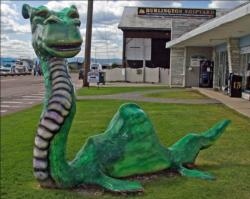 Lake Champlain also boasts plenty of captivating mythology as well. Lake Champlain’s most elusive tourism element is the legendary water creature known as The Lake Champlain Monster, or “Champ.” T-shirts, coffee mugs and figurines commemorating this mythical beast are many. In fact, there’s even a minor league baseball team named the Vermont Lake Monsters. In addition, you’ll spot statues and artwork of the mythical creature in lakeside communities, but that’s usually the closest most ever get to a sighting.
Lake Champlain also boasts plenty of captivating mythology as well. Lake Champlain’s most elusive tourism element is the legendary water creature known as The Lake Champlain Monster, or “Champ.” T-shirts, coffee mugs and figurines commemorating this mythical beast are many. In fact, there’s even a minor league baseball team named the Vermont Lake Monsters. In addition, you’ll spot statues and artwork of the mythical creature in lakeside communities, but that’s usually the closest most ever get to a sighting.
Getting there
By air, the Plattsburgh Airport has limited arrivals, but Burlington International Airport offers a broader airline schedule with on-site car rentals. Vermont Hwy. 2 runs west to the waterfront district, where you can catch a Ferry that links Burlington and Port Kent, N.Y. This route takes about an hour to cross the lake. While it’s a bit time-consuming, it’s a nice ride with great views. However, if you’re in a hurry to cross, take Hwy. 2 west to Hwy. 7 north across the Winooski River and grab Interstate 89 north to exit 17. Take Highway 2 across a causeway and follow the signs to the Grand Isle ferry for a 20-minute crossing to Plattsburgh. At Champlain’s south end, a third ferry takes 12 minutes to run between Charlotte, Vt., and Essex, N.Y. For schedules and fees, visit Ferries.com
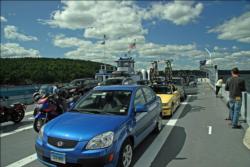 If you plan to hop across to Canada, you’ll need a passport. Anglers also will need New York, Vermont and Canadian fishing licenses to enjoy complete lake access.
If you plan to hop across to Canada, you’ll need a passport. Anglers also will need New York, Vermont and Canadian fishing licenses to enjoy complete lake access.
For information on Lake Champlain visit lakechamplainregion.com.